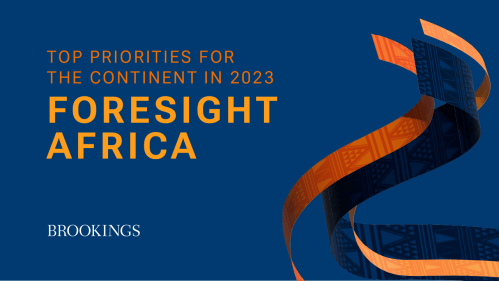Below is a viewpoint from the Foresight Africa 2023 report, which explores top priorities for the region in the coming year. Read the full chapter on economic recovery and growth.
 The last seven years (2015–2021) have been tough for Nigerians. During this period, GDP growth averaged 1.1 percent as the country experienced two economic recessions. Unemployment and underemployment rates increased to an all-time high of 56.1 percent in 2020, pushing 133 million Nigerians into multidimensional poverty, according to the latest data from the National Bureau of Statistics. Likewise, economic growth has not been inclusive, and Nigeria’s economy faced key challenges of lower productivity, and the weak expansion of sectors with high employment elasticity.
The last seven years (2015–2021) have been tough for Nigerians. During this period, GDP growth averaged 1.1 percent as the country experienced two economic recessions. Unemployment and underemployment rates increased to an all-time high of 56.1 percent in 2020, pushing 133 million Nigerians into multidimensional poverty, according to the latest data from the National Bureau of Statistics. Likewise, economic growth has not been inclusive, and Nigeria’s economy faced key challenges of lower productivity, and the weak expansion of sectors with high employment elasticity.
Another key feature of Nigeria’s economy in the last seven years has been the shift of economic activity towards agriculture and a slowdown of the manufacturing sector. As a share of GDP, agriculture expanded from 23 percent in 2015 to 26 percent in 2021, while manufacturing declined from 9.5 percent to 9 percent respectively. During this period, non-oil exports as a share of non-oil GDP averaged 1.3 percent while manufactured goods as a share of total exports remained low at 5.2 percent in 2021. Part of the problem facing the economy is the neglect of the manufacturing sector. Essentially, Nigeria is not producing enough, for both local consumption and export. The consequences of having a weak manufacturing base for a country with such a large population are evident in its foreign exchange shortages, limited number of jobs created to accommodate workforce entrants, and an import bill that can hardly be met (nor sustained) by current export earnings.
Worse still, 80 percent of workers are employed in sectors with low levels of productivity—agriculture and non-tradable services. This means that the kind of jobs needed to generate income growth and lift many Nigerians out of poverty are not available in large numbers. As Nigeria approaches the general elections in 2023, there is immense pressure on political leaders to tackle these economic challenges and implement policies that will deliver an inclusive and competitive economy.
As Nigeria approaches the general elections in 2023, there is immense pressure on political leaders to tackle these economic challenges and implement policies that will deliver an inclusive and competitive economy.
The new administration, working with stakeholders, needs to develop an agenda for economic and social inclusion. At the heart of such agenda must be improving the lives of the average Nigerian. This agenda must also include a practical strategy on how to structurally transform the economy, moving labor and economic resources from low productivity sectors to high productivity sectors.
At the top of the productivity ladder is the tradable services sector, which has the potential to improve incomes and raise overall productivity. The challenge with this sector, however, is its inability to accommodate labor in large numbers. Nevertheless, the sector is important, given Nigeria’s young population who are increasingly driving technological revolution across various sectors on the African continent. To leverage the full potential of this sector, the government will need to design and implement national skills programs aimed at upskilling young Nigerians, to ensure many more embrace digital skills and capabilities.
At the middle of the productivity ladder sits manufacturing. The sector has a much higher productivity level than agriculture and can accommodate, in large numbers, the kind of labor that is abundant in the country. Nigeria’s rising population (which is projected to reach 428 million by 2050), the existence of mineral resources, and the adoption of a single market in Africa—the African Continental Free Trade Area (AfCFTA)—present a case for why manufacturing would thrive in Nigeria. The priority, therefore, for the incoming government must be to address the burgeoning infrastructure deficit and inadequate power supply, which limit the competitiveness of the manufacturing sector. In addition, the government will need to develop an industrial policy that seeks to support the scale, efficiency, and competitiveness of local firms within the manufacturing sector; bearing in mind that developing the sector is key to building economic resilience against vulnerability and future shocks. Such policies must be integrated with Nigeria’s AfCFTA strategy and support transition of small-scale firms that are often the drivers of job creation in the country.






Commentary
Nigeria in 2023: Bridging the productivity gap and building economic resilience
February 6, 2023